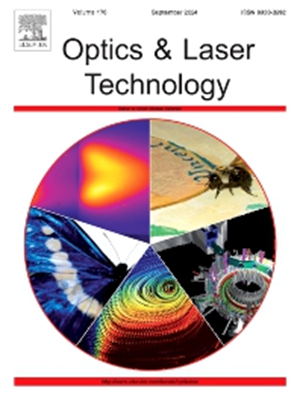Optimal process parameter combinations search for desired deposited layer geometry in laser-arc hybrid additive manufacturing based on multi-pass overlapping deposited layer contour prediction model and improved NSGA-II algorithm
IF 4.6
2区 物理与天体物理
Q1 OPTICS
引用次数: 0
Abstract
Laser-arc hybrid additive manufacturing (LHAM) leverages the synergistic effect of a combined laser-arc heat source to overcome the limitations of both laser additive manufacturing (LAM) and wire arc additive manufacturing (WAAM). As an advanced process, LHAM holds significant potential for development within the realm of metal additive manufacturing (MAM). How to achieve an optimal combination of process parameters based on the ideal deposited layer geometry of LHAM is a key issue that constrains the maturation of the LHAM process. In this study, an automated solution for obtaining the ideal deposited layer and searching for optimal process parameter combination for LHAM multi-pass overlapping was investigated. Orthogonal experiment was designed to obtain the original data of LHAM multi-pass overlapping deposited layer. Parabolic curve was used to fit the LHAM single-pass layer contour and a multi-pass overlapping layer contour prediction model was constructed based on the iterative approach. The accuracy of the prediction model was evaluated using three metrics. Aiming at the shortcomings of the second-generation non-dominated genetic algorithm (NSGA-II), an improved NSGA-II algorithm was proposed, and an optimisation model for the combination of process parameters was constructed by combining the entropy-weight TOPSIS method. The optimisation model was able to automatically optimise the process parameter combinations through the expected deposition layer morphology parameters. The relative error of the actual height of the multi-pass overlapping layer from the preset height selected by the optimal combination of process parameters was only 2.067%, and a smoother surface of the layer was obtained, which verified the feasibility of the optimisation model.
激光-电弧混合增材制造(LHAM)利用激光-电弧组合热源的协同效应,克服了激光增材制造(LAM)和线弧增材制造(WAAM)的局限性。作为一种先进工艺,LHAM 在金属快速成型制造 (MAM) 领域具有巨大的发展潜力。如何根据 LHAM 理想沉积层的几何形状实现工艺参数的优化组合,是制约 LHAM 工艺成熟的关键问题。在本研究中,研究了一种自动解决方案,用于获取理想沉积层并搜索 LHAM 多道重叠的最佳工艺参数组合。设计了正交实验来获取 LHAM 多道重叠沉积层的原始数据。采用抛物线拟合 LHAM 单程层轮廓,并基于迭代法构建了多程重叠层轮廓预测模型。预测模型的准确性通过三个指标进行了评估。针对第二代非优势遗传算法(NSGA-II)的不足,提出了改进的 NSGA-II 算法,并结合熵权 TOPSIS 法构建了工艺参数组合优化模型。该优化模型能够通过预期的沉积层形态参数自动优化工艺参数组合。多道重叠层的实际高度与工艺参数优化组合所选择的预设高度的相对误差仅为 2.067%,并获得了更光滑的层表面,验证了优化模型的可行性。
本文章由计算机程序翻译,如有差异,请以英文原文为准。
求助全文
约1分钟内获得全文
求助全文
来源期刊
CiteScore
8.50
自引率
10.00%
发文量
1060
审稿时长
3.4 months
期刊介绍:
Optics & Laser Technology aims to provide a vehicle for the publication of a broad range of high quality research and review papers in those fields of scientific and engineering research appertaining to the development and application of the technology of optics and lasers. Papers describing original work in these areas are submitted to rigorous refereeing prior to acceptance for publication.
The scope of Optics & Laser Technology encompasses, but is not restricted to, the following areas:
•development in all types of lasers
•developments in optoelectronic devices and photonics
•developments in new photonics and optical concepts
•developments in conventional optics, optical instruments and components
•techniques of optical metrology, including interferometry and optical fibre sensors
•LIDAR and other non-contact optical measurement techniques, including optical methods in heat and fluid flow
•applications of lasers to materials processing, optical NDT display (including holography) and optical communication
•research and development in the field of laser safety including studies of hazards resulting from the applications of lasers (laser safety, hazards of laser fume)
•developments in optical computing and optical information processing
•developments in new optical materials
•developments in new optical characterization methods and techniques
•developments in quantum optics
•developments in light assisted micro and nanofabrication methods and techniques
•developments in nanophotonics and biophotonics
•developments in imaging processing and systems

 求助内容:
求助内容: 应助结果提醒方式:
应助结果提醒方式:


